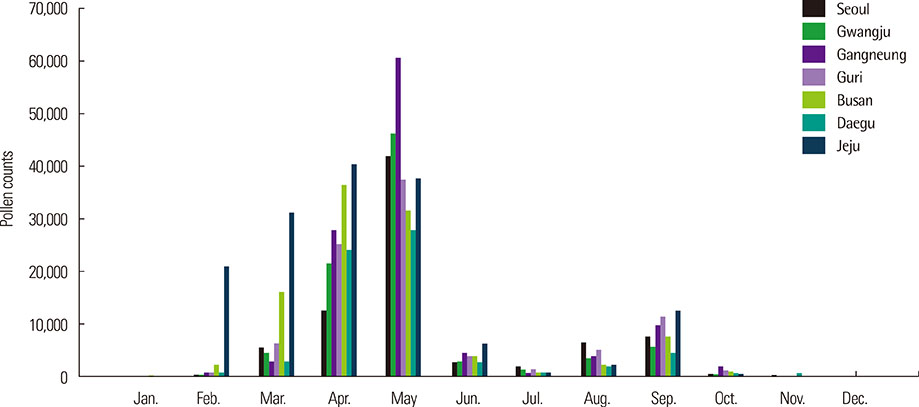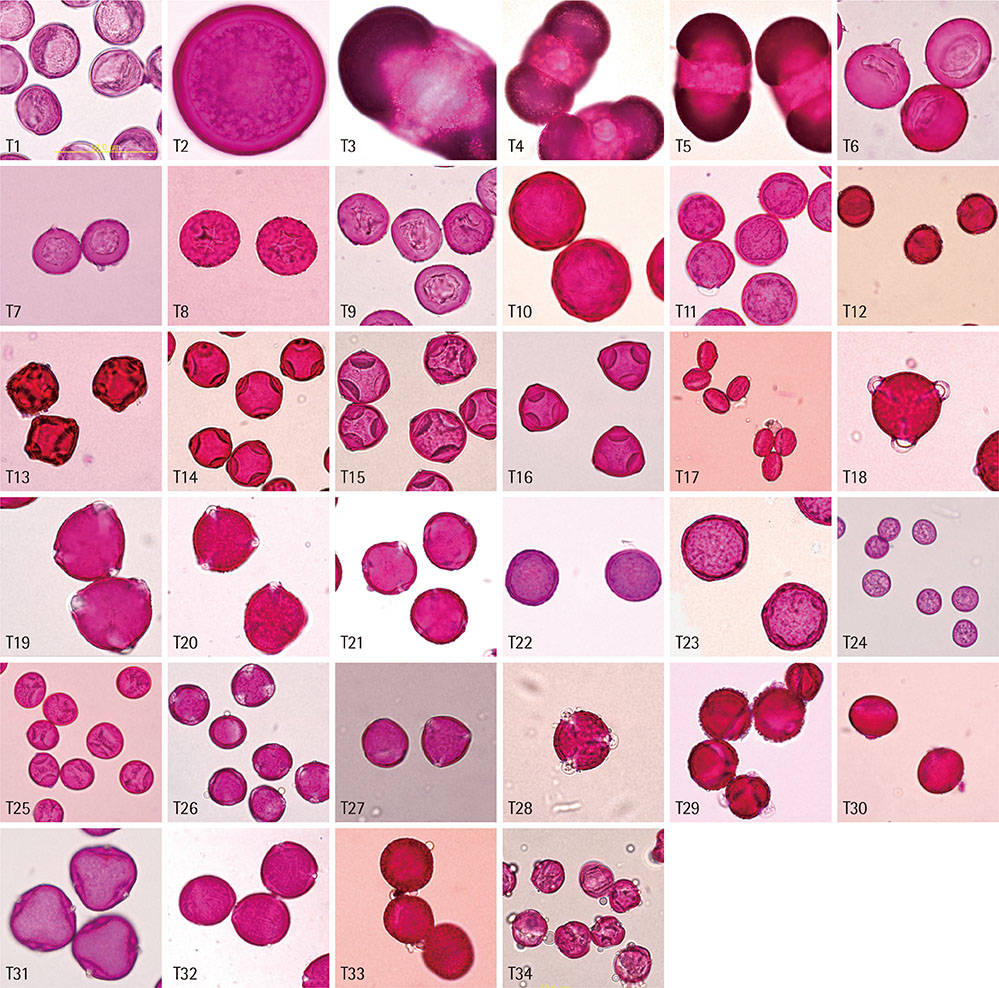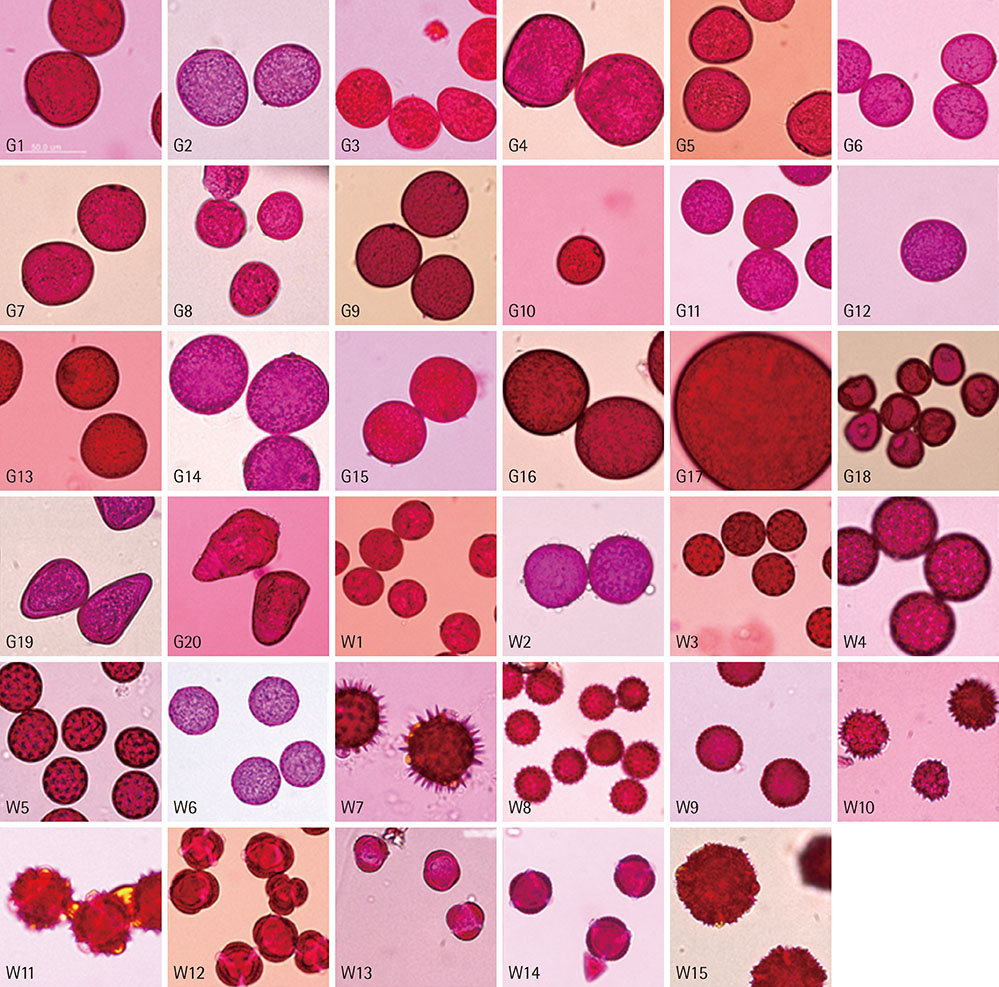Allergy Asthma Respir Dis.
2015 Jul;3(4):239-254. 10.4168/aard.2015.3.4.239.
Pollen allergy plants in Korea
- Affiliations
-
- 1Division of Allergy and Immunology, Department of Internal Medicine, Yonsei University College of Medicine, Seoul, Korea. cshong@yuhs.ac
- KMID: 2218653
- DOI: http://doi.org/10.4168/aard.2015.3.4.239
Abstract
- Pollen reactivity in respiratory allergic diseases has recently increased in Korea. According to changes in allergen sensitization over the last 30 years, tree pollen sensitization in the 2010s markedly increased in oak, birch, alder, and pine. The sensitization to grasses and most weeds in the 2010s decreased in comparison with the 90s results. Oak Pollen allergens have increased in air during the last 30 years, and this increment has been correlated with increased oak reactivity. The number of birch trees is not so many as oak, but skin reactivity to birch pollen is as same as that to oak pollen. Because there are many chestnut near the residence, sensitization to Castanea spp. has to be evaluated. Maidenhair tree and Japanese elm are regarded as offending allergens of pollenosis. There are many maindenhair trees (Ginkgo biloba) and Japanese elm (Zelkova serrata) on streets and in park areas, and they produce a large amount of anemophilous pollen in spring. There is little wide grassland in Korea except the rice fields. Therefore, we do not have dominant grasses for pollenosis. There are a few peculiar grasses, such as orange foxtail, common reed, Korean lawn grass, Chinese silver grass, and green bristle grass. These pollens should be evaluated for cross-allergenicity with known allergenic pollens, such as timothy and Bermuda grass. In Korea, sagebrush, ragweed, and hop Japanese are prominent plants in autumn. Chrysanthemum spp. should be further evaluated because of persistently increased sensitization during the last 30 years, which are widely distributed in wild fields and bloom massively during late autumn. Recent climate changes and air pollution increase pollen production and alter pollen allergenicity. Therefore, continuous monitoring of plant ecology and pollen sensitization is necessary in effectively controlling pollen allergy for human health.
Keyword
MeSH Terms
Figure
Cited by 3 articles
-
Deep Neural Network-Based Concentration Model for Oak Pollen Allergy Warning in South Korea
Yun Am Seo, Kyu Rang Kim, Changbum Cho, Jae-Won Oh, Tae Hee Kim
Allergy Asthma Immunol Res. 2020;12(1):149-163. doi: 10.4168/aair.2020.12.1.149.Evaluation of the allergenic relationship between
Humulus japonicus andHumulus lupulus pollen allergens
Chang-Gyu Jung, Eun-Mi Yang, Ji-Ho Lee, Hyun Mi Kim, Hae-Sim Park
Allergy Asthma Respir Dis. 2017;5(4):217-222. doi: 10.4168/aard.2017.5.4.217.A study on the correlation between outbreak of allergic rhinitis and airborne pollen in September
Jong Seok Kim, ye Joo So, Jeong Hee Kim, Dae Hyun Lim
Allergy Asthma Respir Dis. 2019;7(4):192-198. doi: 10.4168/aard.2019.7.4.192.
Reference
-
1. Park HJ, Lim HS, Park KH, Lee JH, Park JW, Hong CS. Changes in allergen sensitization over the last 30 years in Korea respiratory allergic patients: a single-center. Allergy Asthma Immunol Res. 2014; 6:434–443.
Article2. Yun JI. Climate change impact on the flowering season of Japanese Cherry (Prunus serrulata var. spontanea) in Korea during 1941-2100. Korean J Agric For Meteorol. 2006; 8:68–76.3. Lewis WH, Vinay P. North American pollinosis due to insect-pollinated plants. Ann Allergy. 1979; 42:309–318.4. Park HJ, Hur GY, Kim HA, Ye YM, Suh CH, Nahm DH, et al. Anaphylactic reaction after the ingestion of bee pollen. Korean J Asthma Allergy Clin Immunol. 2007; 27:57–60.5. Choi JH, Jang YS, Oh JW, Kim CH, Hyun IG. Bee pollen-induced anaphylaxis: a case report and literature review. Allergy Asthma Immunol Res. 2015; 7:513–517.
Article6. Joo YJ. Sutides of pollinosis. Report 2. Sensitization with pollens in Korea. J Korean Otol Soc. 1965; 8:23–32.7. Kang SY. Studies on the offending allergen of allergic respiratory diseases in Korea. Korean J Intern Med. 1973; 16:373–378.8. Whang YN, Huh KB, Lee SY. Clinical observation and skin test for bronchial asthma. Korean J Intern Med. 1974; 17:426–437.9. Kim KM. Clinical and statistical study of allergens in the allergic rhinitis. Korean J Otolaryngol-Head Neck Surg. 1975; 18:39–49.
Article10. Cho SS, Lee HL, Suck JW, Moon SH, Sohn KC. Survey on skin reactivity test in pediatric allergic diseases. Allergy. 1981; 1:83–87.11. Min KU, Moon HB, Kang SY. Aerobiological and allergological study for airborne pollen in Seoul. Allergy. 1984; 4:1–20.12. Kim YL, Lee SK, Oh SH, Moon BS, Park HS, Hong CS. A study of allergy skin tests with Korean pollen extracts. Yonsei Med J. 1987; 28:112–118.
Article13. Nam DK, Park HS, Oh SH, Hong CS. Skin reactivity and the detection of specific IgE to the pollen of Humulus Japonicus. Korean J Intern Med. 1988; 35:213–227.14. Joo YJ. Studies on pollinosis: pollen survey in Seoul. Korean J Otolaryngol-Head Neck Surg. 1965; 8:11–22.15. Kim JJ. Distribution of airborne allergen in Seoul. Pediatrics. 1967; 16:8–11.16. Hong CS, Hwang Y, Oh SH, Kim HJ, Huh KB, Lee SY. Survey of the airborne pollens in Seoul, Korea. Yonsei Med J. 1986; 27:114–120.
Article17. Kim HS, Lee MK, Park HS, Kim HJ, Hong CS. Pollen counts in the air of Seoul during 88 Seoul Olymphics. Allergy. 1989; 9:564–570.18. Park HS, Chung DH, Joo YJ. Survey of airborne pollens in Seoul, Korea. J Korean Med Sci. 1994; 9:42–46.
Article19. Oh JW, Lee HB, Lee HR, Pyun BY, Ahn YM, Kim KE, et al. Aerobiological study of pollen and mold in Seoul, Korea. Allergol Int. 1998; 47:263–270.
Article20. Park KJ, Kim HA, Kim KR, Oh JW, Lee SY, Choi YJ. Characteristics of regional distribution of pollen concentration in Korean Peninsula. Korean J Agric For Meteorol. 2008; 10:167–176.
Article21. Oh JW, Lee HB, Kang IJ, Kim SW, Park KS, Kook MH, et al. The revised edition of Korean calendar for allergenic pollens. Allergy Asthma Immunol Res. 2012; 4:5–11.
Article22. Lee CB. Korean illustrated plant book. Seoul: Mi-Moon Sa;1979.23. Laurent J, Lafay M, Lattanzi B, Le Gall C, Sauvaget J. Evidence for chestnut pollinosis in Paris. Clin Exp Allergy. 1993; 23:39–43.
Article24. Eriksson NE, Wihl JA, Arrendal H, Strandhede SO. Tree pollen allergy. III. Cross reactions based on results from skin prick tests and the RAST in hay fever patients. A multi-centre study. Allergy. 1987; 42:205–214.25. May KL. Sensitivity to birch pollen--under-appreciated etiology of atopic asthma in towns. Pneumonol Alergol Pol. 2000; 68:478–485.26. de Groot H, de Jong NW, Vuijk MH, Gerth van Wijk R. Birch pollinosis and atopy caused by apple, peach, and hazelnut; comparison of three extraction procedures with two apple strains. Allergy. 1996; 51:712–718.
Article27. Vieths S, Scheurer S, Ballmer-Weber B. Current understanding of cross-reactivity of food allergens and pollen. Ann N Y Acad Sci. 2002; 964:47–68.
Article28. Schenk MF, Cordewener JH, America AH, Peters J, Smulders MJ, Gilissen LJ. Proteomic analysis of the major birch allergen Bet v 1 predicts allergenicity for 15 birch species. J Proteomics. 2011; 74:1290–1300.
Article29. Kim TB, Kim KM, Kim SH, Kang HR, Chang YS, Kim CW, et al. Sensitization rates for inhalant allergens in Korea; a multi-center study. J Asthma Allergy Clin Immunol. 2003; 23:483–493.30. Harris RM, German DF. The incidence of pine pollen reactivity in an allergic atopic population. Ann Allergy. 1985; 55:678–679.31. Freeman GL. Pine pollen allergy in northern Arizona. Ann Allergy. 1993; 70:491–494.32. Gastaminza G, Lombardero M, Bernaola G, Antepara I, Munoz D, Gamboa PM, et al. Allergenicity and cross-reactivity of pine pollen. Clin Exp Allergy. 2009; 39:1438–1446.
Article33. Dales RE, Cakmak S, Judek S, Coates F. Tree pollen and hospitalization for asthma in urban Canada. Int Arch Allergy Immunol. 2008; 146:241–247.
Article34. Dirksen A, Osterballe O. Common components in pollen extracts. Allergy. 1980; 35:611–616.
Article35. Weber RW. Cross-reactivity of plant and animal allergens. Clin Rev Allergy Immunol. 2001; 21:153–202.
Article36. Sneller MR, Hayes HD, Pinnas JL. Pollen changes during five decades of urbanization in Tucson, Arizona. Ann Allergy. 1993; 71:519–524.37. Micheal S, Wangorsch A, Wolfheimer S, Foetisch K, Minhas K, Scheurer S, et al. Immunoglobulin E reactivity and allergenic potency of Morus papyrifera (paper mulberry) pollen. J Investig Allergol Clin Immunol. 2013; 23:168–175.38. Zanforlin M, Incorvaia C. A case of pollinosis to Broussonetia papyrifera. Allergy. 2004; 59:1136–1137.
Article39. Liu GH, Zhu RF, Zhang W, Li WJ, Wang ZX, Chen H. Survey of airborne pollen in Hubei province of China. Chin Med Sci J. 2008; 23:212–217.
Article40. Chen Z, Zhu N, Chen X, Yang Y, Li Y, Wu Z, et al. Purification and identification of 72 kDa and 15 kDa allergens from Broussonetia papyrifera pollen. Iran J Allergy Asthma Immunol. 2013; 12:312–320.41. Shida T, Akiyama K, Hasegawa M, Maeda Y, Taniguchi M, Mori A, et al. Change in skin reactivity to common allergens in allergic patients over a 30-year period. Association with aeroallergen load. Arerugi. 2000; 49:1074–1086.42. Wodehouse RP. Hayfever plants; their appearance, distribution, time of flowering, and their role in hayfever. New York: Hafner Pub. Co.;1971.43. Schwietz LA, Goetz DW, Whisman BA, Reid MJ. Cross-reactivity among conifer pollens. Ann Allergy Asthma Immunol. 2000; 84:87–93.
Article44. Lewis WH, Vinay P, Zenger VE. Airborne and allergenic pollen of North America. Baltimore: Johns Hopkins University Press;1983.45. Bernstein IL, Perera M, Gallagher J, Michael JG, Johansson SG. In vitro cross-allergenicity of major aeroallergenic pollens by the radioallergosorbent technique. J Allergy Clin Immunol. 1976; 57:141–152.
Article46. Berna Dursun A, Celik GE, Alan S, Münevver Pinar N, Mungan D, Misirligil Z. Regional pollen load: effect on sensitisation and clinical presentation of seasonal allergic rhinitis in patients living in Ankara, Turkey. Allergol Immunopathol (Madr). 2008; 36:371–378.
Article47. Lee MK, Hong CS. Characterization of allergen in Zoysia japonica pollen. Allergy. 1991; 11:14–29.48. Weber RW. Patterns of pollen cross-allergenicity. J Allergy Clin Immunol. 2003; 112:229–239.
Article49. Weber RW. Cross-reactivity of pollen allergens. Curr Allergy Asthma Rep. 2004; 4:401–408.
Article50. Wopfner N, Gadermaier G, Egger M, Asero R, Ebner C, Jahn-Schmid B, et al. The spectrum of allergens in ragweed and mugwort pollen. Int Arch Allergy Immunol. 2005; 138:337–346.
Article51. Katial RK, Lin FL, Stafford WW, Ledoux RA, Westley CR, Weber RW. Mugwort and sage (Artemisia) pollen cross-reactivity: ELISA inhibition and immunoblot evaluation. Ann Allergy Asthma Immunol. 1997; 79:340–346.
Article52. Brandys J, Grimsøen A, Nilsen BM, Paulsen BS, Park HS, Hong CS. Cross-reactivity between pollen extracts from six artemisia species. Planta Med. 1993; 59:221–228.
Article53. Yunginger JW, Gleich GJ. Measurement of ragweed antigen E by double antibody radioimmunoassay. J Allergy Clin Immunol. 1972; 50:326–337.
Article54. Kuroume T, Todokoro M, Tomidokoro H, Kanbe Y, Matsumura T. Chrysanthemum pollinosis in Japan. Int Arch Allergy Appl Immunol. 1975; 48:800–811.
Article55. Park HS, Jung KS, Jee SY, Hong SH, Kim HY, Nahm DH. Are there any links between Hop Japanese pollen and other weed pollens or food allergens on skin prick tests? Allergy Asthma Proc. 2001; 22:43–46.
Article56. Reeb-Whitaker CK, Bonauto DK. Respiratory disease associated with occupational inhalation to hop (Humulus lupulus) during harvest and processing. Ann Allergy Asthma Immunol. 2014; 113:534–538.
Article57. Leiferman KM, Gleich GJ, Jones RT. The cross-reactivity of IgE antibodies with pollen allergens. II. Analyses of various species of ragweed and other fall weed pollens. J Allergy Clin Immunol. 1976; 58(1 Pt 2):140–148.58. Galant S, Berger W, Gillman S, Goldsobel A, Incaudo G, Kanter L, et al. Prevalence of sensitization to aeroallergens in California patients with respiratory allergy. Allergy Skin Test Project Team. Ann Allergy Asthma Immunol. 1998; 81:203–210.
Article59. Lombardero M, Duffort O, Selles JG, Hernandez J, Carreira J. Cross-reactivity among Chenopodiaceae and Amaranthaceae. Ann Allergy. 1985; 54:430–436.60. Crosby B, Ledoux R, Vaughan T, Weber R, Goodman D. Crossallergenicity amongst chenopod-amaranth weeds: assessment via ELISA inhibition & enzyme-linked immunoblot assays [abstract]. J Allergy Clin Immunol. 1990; 85:176.61. Mehta V, Wheeler AW. IgE-mediated sensitization to English plantain pollen in seasonal respiratory allergy: identification and partial characterisation of its allergenic components. Int Arch Allergy Appl Immunol. 1991; 96:211–217.
Article62. Nakamaru Y, Maguchi S, Oridate N, Takagi D, Furuta Y, Fukuda S. Plantago lanceolata (English plantain) pollinosis in Japan. Auris Nasus Larynx. 2005; 32:251–256.
Article
- Full Text Links
- Actions
-
Cited
- CITED
-
- Close
- Share
- Similar articles
-
- Sunflower seed allergy:cross-reactivity with mugwort pollen
- Characteristics of Allergic Pollen and the Pollen Amount was Recently Changed in Korea
- Charaterization of allergen in Zoysia japonica pollen
- Pollen Sensitization and Clinical Significance in Childhood
- Characteristics and Distribution of Airborne Pollen and Mold




